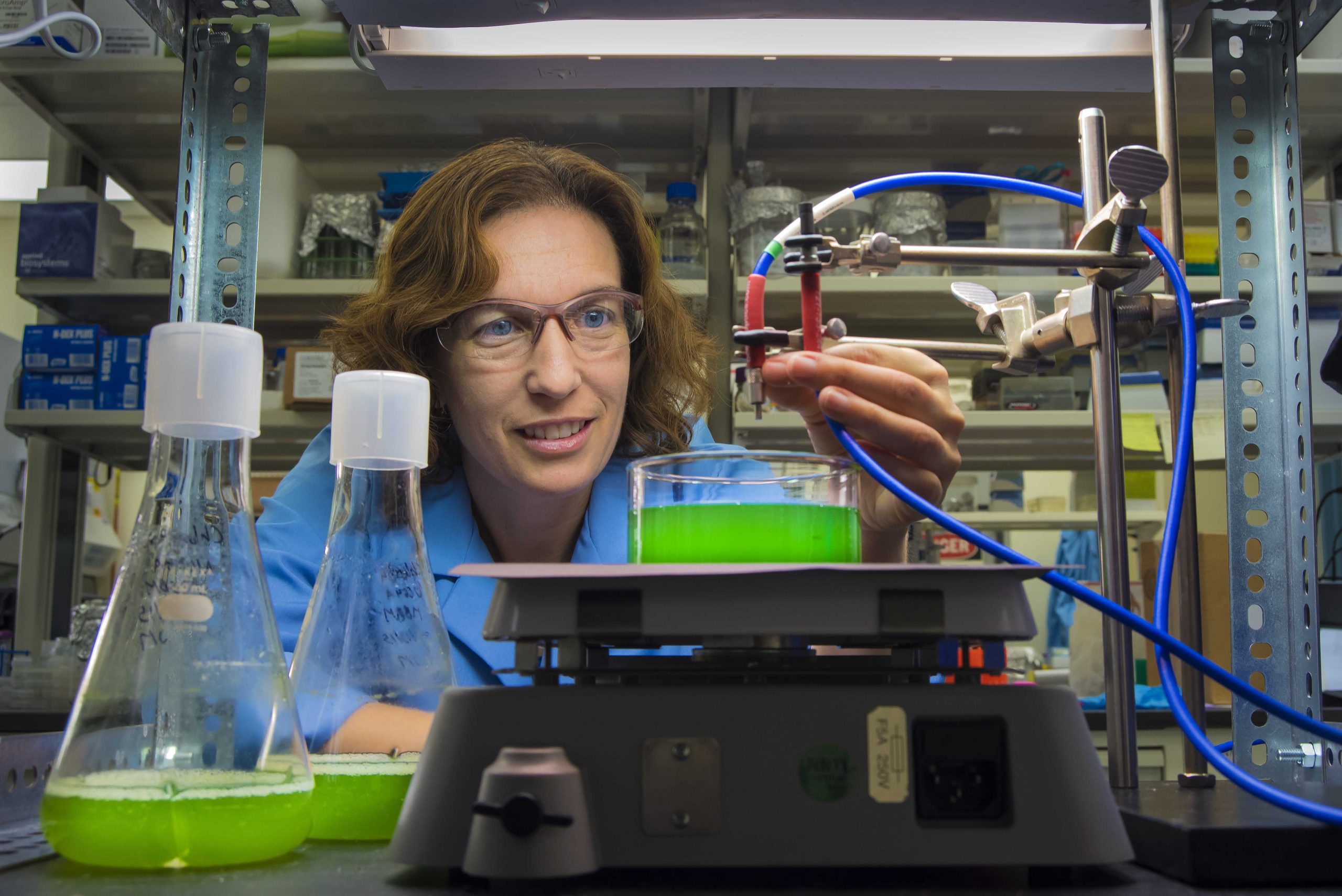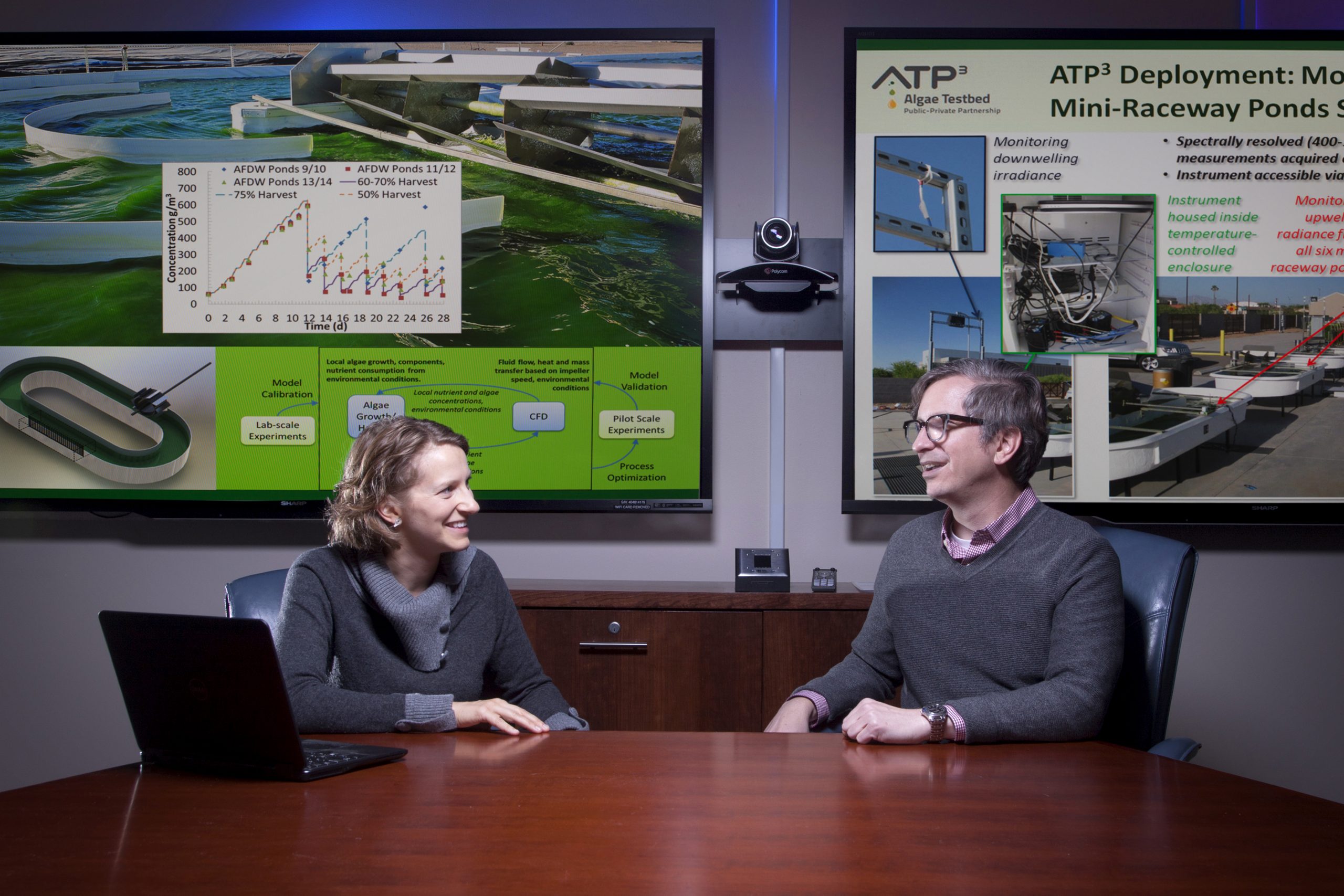Work part of a broader framework for funding energy-related science, technology
LIVERMORE, Calif.— Sandia National Laboratories and Arizona State University (ASU) have teamed up to further improve computational models of algae growth in raceway ponds that can predict performance, improve pond design and operation and discover ways to improve algae yield outdoors.

Such ponds consist of an oval-shaped closed-loop channel — or raceway — in which the cultivation mixture of water and algae is propelled to flow around the raceway and undergo mixing by a paddlewheel powered by an electric motor.
In addition, Sandia and ASU will further develop spectroradiometric techniques to optically monitor the growth and health of algae pond cultivation in real-time and detect early warnings of predators and pathogens in outdoor algal ponds.
The work is part of a newly signed Cooperative Research and Development Agreement (CRADA) between ASU and Sandia to collaborate on algae-based biofuels, solar fuels, concentrating solar technologies, photovoltaics, electric grid modernization and the energy-water nexus. The umbrella CRADA also covers international applications of the technologies and science and engineering education. The topics were first identified in a 2013 memo of understanding between Sandia and ASU focusing on collaborations to support science, technology, engineering and mathematics, or STEM, fields.
This is the first CRADA Sandia has executed with a university in nearly 15 years and is currently the only active umbrella CRADA with an institution of higher education. The algae cultivation modeling and monitoring projects are the first two efforts funded under this umbrella CRADA.
Sandia researcher Ron Pate said Sandia brings distinctive capabilities for physics-based modeling of algae cultivation systems performance and for remote spectroradiometric monitoring and diagnostics of algae growth and state of health, while ASU has a variety of algae species under cultivation in outdoor ponds in a range of scales in which to take measurements.
“Sandia is excited about the collaboration with ASU,” Pate said. “This agreement allows Sandia to continue modeling and monitoring work that we have been pursuing with ASU since 2013 under the original ATP3 (Algae Testbed Public-Private Partnership) project.” Pate serves as deputy director for ATP3, overseeing Sandia technical tasks under the project.
The ATP3 project was established to support the algae research and development community and industry to advance the field and help accelerate progress toward more rapid and successful commercialization of algae-based technologies for fuels and products. ATP3 is funded by the DOE’s Energy Efficiency and Renewable Energy Bioenergy Technologies Office. ATP3 partners include Sandia, ASU, the National Renewable Energy Laboratory, California Polytechnic State University in San Luis Obispo, the Georgia Institute of Technology in Atlanta and the algae companies San Diego-based Cellana Inc. with algae cultivation facilities in Kona, Hawaii, Commercial Algae Management in Franklin, North Carolina and Florida Algae in Vero Beach, Florida.
Two projects exercise new Sandia, ASU CRADA

The first project under the agreement, Algal Cultivation Growth Dynamic Modeling and Analysis, focuses on the further development of a Sandia algae growth model based on the effect of light, temperature, nutrients, pH and salinity integrated into an open raceway pond hydrodynamic computational fluid dynamics model. The algae growth model has been partially validated utilizing multiple data sets from partners involved in ATP3. Under the CRADA, the modeling will be further refined through improvement of the paddlewheel driven pond circulation flow and mixing portion of the model based on the application of hydrodynamic measurement data taken from experimental testing with progressively larger scale outdoor ponds operated by ATP3 partners.
The 12-month project, led by principal investigators Patricia Gharagozloo from Sandia and John McGowen from ASU, will be conducted in two phases. The first phase will study the flow dynamics of turbulence models and control parameters in open raceway ponds, which are currently the most promising outdoor cultivation system approach for cost-effectively growing algae at the large scales required for producing fuels. In this phase, ASU will measure the spatial variations in velocity of the flow of algae-water mix in the ponds at various paddlewheel speeds.
The second phase will calibrate the model and verify the appropriate turbulence physics to be accounted for at certain scales of ponds for one paddlewheel speed. After the two phases, a study will be conducted to compare the data with model results at additional paddlewheel speeds.
The second 12-month project, Algal Predator and Pathogen Signature Verification, looks at exploring and exploiting the various detailed optical signatures that arise when the algae cultivation pond surface is monitored using Sandia’s optical spectroradiometric techniques. These techniques can differentiate algae growth and state of health and provide an early warning of the active presence of predators and pathogens in outdoor algal ponds. Sandia researcher Jerilyn Timlin and McGowen are the principal investigators for this project. Sandia researcher Tom Reichardt, who pioneered the original technology as part of a bioscience Laboratory Directed Research & Development project, also serves as technical contributor to the project.
During the first phase of this project, controlled experiments will be conducted in the laboratory with a host-pathogen-predator pair that the team has seen cause problems in the field in order to understand the parameters that control culture collapse and identify spectral markers that indicate the presence of the pathogen or predator. The second phase will consist of experiments in the field to determine how well the identified spectral markers predict the presence of the pathogen or predator in the challenges of an outdoor environment.
“The continuation of the technical work related to algae biofuels, which began under the ATP3 project, is a great opportunity to exercise this new Sandia-ASU CRADA,” Pate said. “However, collaborative work on the other STEM topic areas could also be pursued in the future as funding becomes available and the mutual interest exists at ASU and Sandia.”